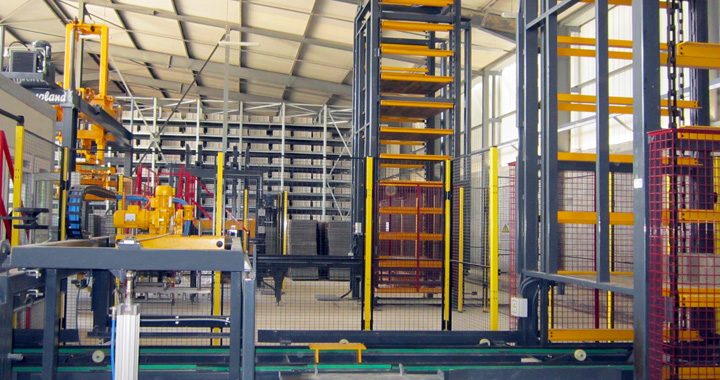Compacta is a line of presses and auxiliary equipment developed by Prensoland for the manufacture of pre-fabricated concrete or cement products: blocks, pavement slabs, vault stones, and kerbstones, etc. Its robust construction, versatility and excellent characteristics in terms of both production and profitability make Compacta the best choice when it comes to investing in pre-fabricated concrete production.
Compacta offers a number of models and circuit configurations in our block makers; from a simple circuit, which requires a certain level of manual input for operation, to totally automated circuits, which are prepared for large-scale production requirements.
The manufacturing process is outlined below, detailing the machines and accessories used in the manufacture of prefabricated concrete products.
The Concreting Plant
This area is used to control aggregate, cement and water dosage, before mixing the cement, which is then fed to the press in a continued production process. This section consists or hoppers for storing the aggregates, lifting systems, to supply these raw materials to the mixer, cement silos, transporters, weighing equipment and a mixer, which produces the final mix that is continually fed to the press on the conveyor belt.
The Vibrocompressor
Essentially, the vibrocompressor, or cuber is the heart of the block making unit. The vibrating-compressing action is totally automatic, which ensures excellent compacting of the concrete and total uniformity in block manufacture.
The upper part of the cuberconsists of the hopper, which receives the concrete directly from the mixer. Each moulding cycle begins with the filling of a mould with the correct amount of concrete or cement required. Compacting or pressing is then initiated by means of hydraulic pressure from the countermould. This process is then subject to vibration, which aids the compacting process. The process ends with the separation of the countermould and the mould is lifted out and removed, leaving the manufactured, compacted blocks on the tray, which exits the press on a conveyor belt. This belt then leaves the trays in the elevator.
A cycle of three to six blocks per minute cycle is possible, depending on the type of block machine used and the type of product manufactured. Prensolandcurrently builds the following models: Compacta ALPHA, VibroCompacta VMI, Compacta DINAMIC S and COMPACTA EASY, which is characterised by its enormous versatility and its adaptability to different types of circuit.
The Tray Elevator
The tray elevator (or stacker) is a mechanism used for vertically stacking the trays with recently-manufactured products at heights of up to 10 levels, with 2 trays per level.
The Transport Trolley and Rack Transporter
The transport trolley is a moving platform designed to pick up the trays that have been stacked on the tray elevator and transport them to the curing and setting tunnels. It carries out the reverse process during its trajectory, i.e. it picks up the dry products and places them in the tray lowerator, which then takes them to be palletized, wrapped and stored.
Curing Chambers
This is a temporary storage area where products are stored for a short period of time in order to allow them to dry, set and harden. These tunnels are formed by cavities that allow the rack transporter(finger car) to enter, deposit and remove the trays. They may be made from construction materials or metal.
Tray Lowerator
This device carries out the operation of the tray stacker, but in reverse, as its function is to pick up the trays from the curing chambers, and which are ready for use. In this case, the rack transporter returns from the tunnels with the trays and places them into the lowerator, which then in turn places the trays onto a conveyor belt that takes them to the palletizer.
Gantry Palletizer
Each time a tray arrives with products from the tray descender, the palletizer places them together (using its four-sided hydraulic-action clamping pincer claws, with 360º lifting and rotating action)and stacks them onto a pallet at a pre-determined height. At the same time, auxiliary devices carry out operations such as pallet supply, tray collection and pallet strapping.
Transport and Storage
Finally, once the palletshave been stacked, the pallet truck automatically transports them to the storage area. Other delivery transport systems are also available, such as roller-track or slat conveyors.
Synchronisation at an overall level is obviously essential for the proper functioning of this entire operation during this continued, automated process. The entire installation is therefore monitored by the control cabin, which is fitted with the latest technological and electronic developments in order to facilitate management, intelligently monitoring each and every step in the process.

